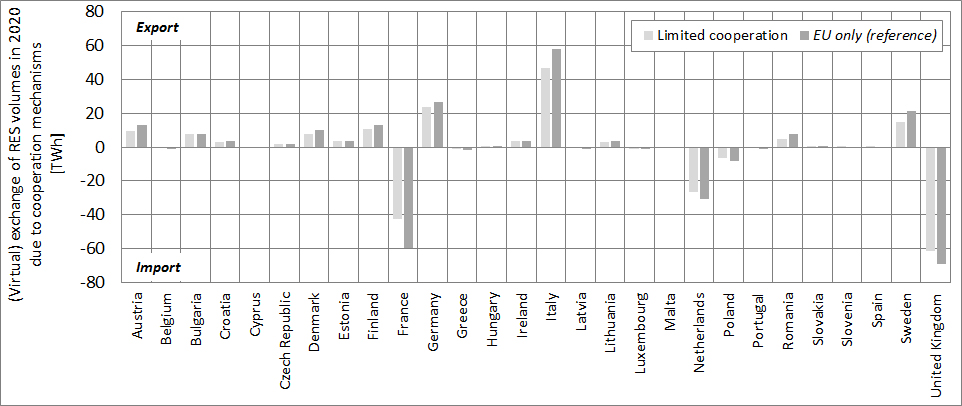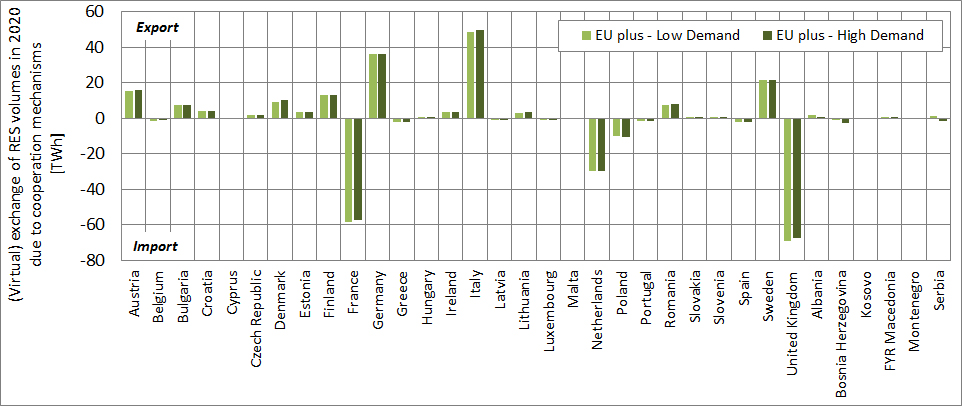
RES cooperation limited to EU Member States: As a starting point, we assess the need for and impact of RES cooperation at EU level, analysing the need for RES exchange in 2020 within the European Union, at Member State level. Please note that assessed neighbouring countries, and in particular RES cooperation in the enlarged geographical context is assessed subsequently.


Figure 3-2: (Virtual) exchange of RES volumes between EU Member States in 2020 according to selected variants of strengthened national RES policies, assuming limited or strong cooperation (EU only, reference case) between Member States, expressed in relative terms (i.e. share in gross final energy demand) (top) and absolute terms (TWh) (bottom)
Figure 3-2 (above) provides a graphical illustration of (virtual) exchange of RES volumes needed in 2020 for RES target fulfilment according to assessed scenarios, showing the remaining resulting import and export volumes in relative terms (i.e. as share of gross final energy demand (top)) and in absolute terms (i.e. TWh (bottom)). Notably, also with tailored national support schemes in place, not all countries have sufficient realisable potentials to fulfil their 2020 RES obligation purely with domestic action. As shown in the graph, Belgium, Cyprus, France, Greece, Latvia, Luxembourg, Malta, the Netherlands, Poland, Portugal and the United Kingdom have to rely, in all cases, on RES imports by 2020, albeit to a very different extent. Summing up the required imports of all related countries, a gap ranging from 140 TWh (in case of limited cooperation) to well above 170 TWh (in case of strong cooperation) occurs which needs to be filled with imports from other Member States which exceed their national obligations. This accounts for roughly 5.5% of the total of required RES deployment by 2020. Thus, this emphasises the need for intensifying cooperation between Member States, even if “national thinking” (of using domestic resources to gain related benefits etc.) maintains its dominance.
RES cooperation extended to Western Balkan countries: Extending the geographical scope of RES cooperation to the Western Balkan region appears, compared to all other analysed cooperation partners (i.e. Turkey and North Africa), as the most relevant and feasible option at short notice, i.e. in the 2020 context. Subsequently we undertake that exercise, aiming to identify opportunities or possible constraints. Figure 3-3 illustrates the (virtual or physical) exchange of RES volumes needed in 2020 for RES target fulfilment according to both assessed EU plus scenarios, showing the resulting import and export volumes in relative terms (i.e. as share of gross final energy demand (top)) and in absolute terms (i.e. TWh (bottom)). Notably, a closer look at EU countries points out only minor differences to the previously discussed case of strong cooperation limited to EU countries only (EU only / reference case). For Western Balkan countries the strong impact of the underlying demand trend is apparent: in the low demand case the achievement of given 2020 RES targets appears feasible for nearly all countries, whereas in the case of high demand (growth) target achievement through solely domestic action appears no longer viable: Kosovo* for example would face a strong challenge to maintain meeting its RES obligation, Macedonia would - similar to Albania - loose large parts of its export opportunities and Serbia would turn from an exporting country to an importer.


Figure 3-3: (Virtual or physical) exchange of RES volumes between EU Member States and Western Balkan countries in 2020 according to assessed EU plus (strong cooperation) scenarios, assuming low or high demand at Western Balkan level and expressed in relative terms (i.e. share in gross final energy demand) (top) and absolute terms (TWh) (bottom)
Summing up, under strong RES cooperation between EU and Western Balkans an ambiguous situation occurs where the future demand development in Western Balkan countries is the key determinant for the flow of exchange:
- In the case of low demand, the Western Balkan region becomes a net exporter, and export to the EU would amount to 2.4 TWh by 2020;
- In the case of a high demand growth the region would however be a net importer, and 4.2 TWh of renewable electricity would then flow from neighbouring EU countries to the Western Balkan region to assure 2020 RES target achievement.
Thus, the economically viable exchange between the EU and the Western Balkan region by 2020 amounts to 2.8% - 4.4% of the required RES volumes at Western Balkans level, or to 0.1% - 0.15% of the corresponding RES deployment target at EU level.
| <<Back | >>Back to Introduction<< | Next>> |